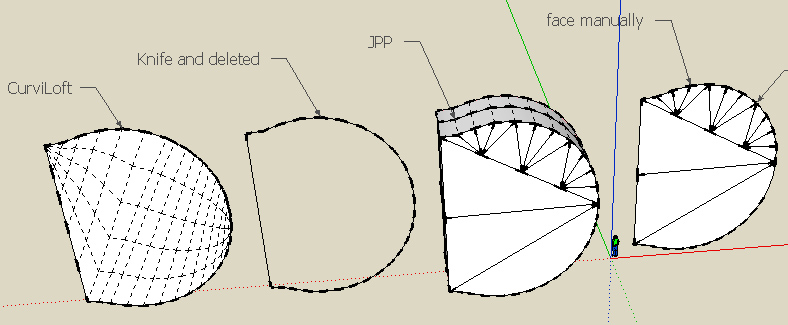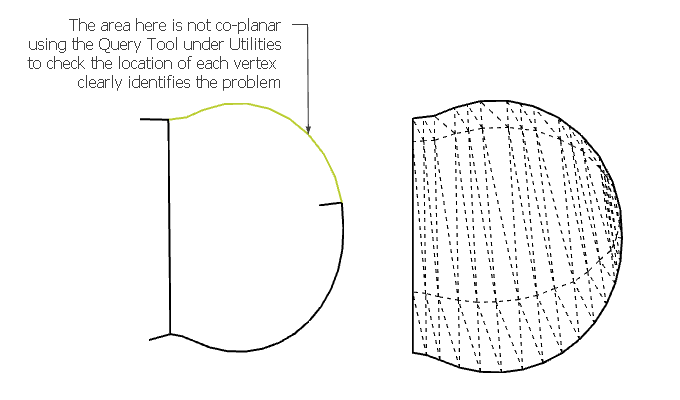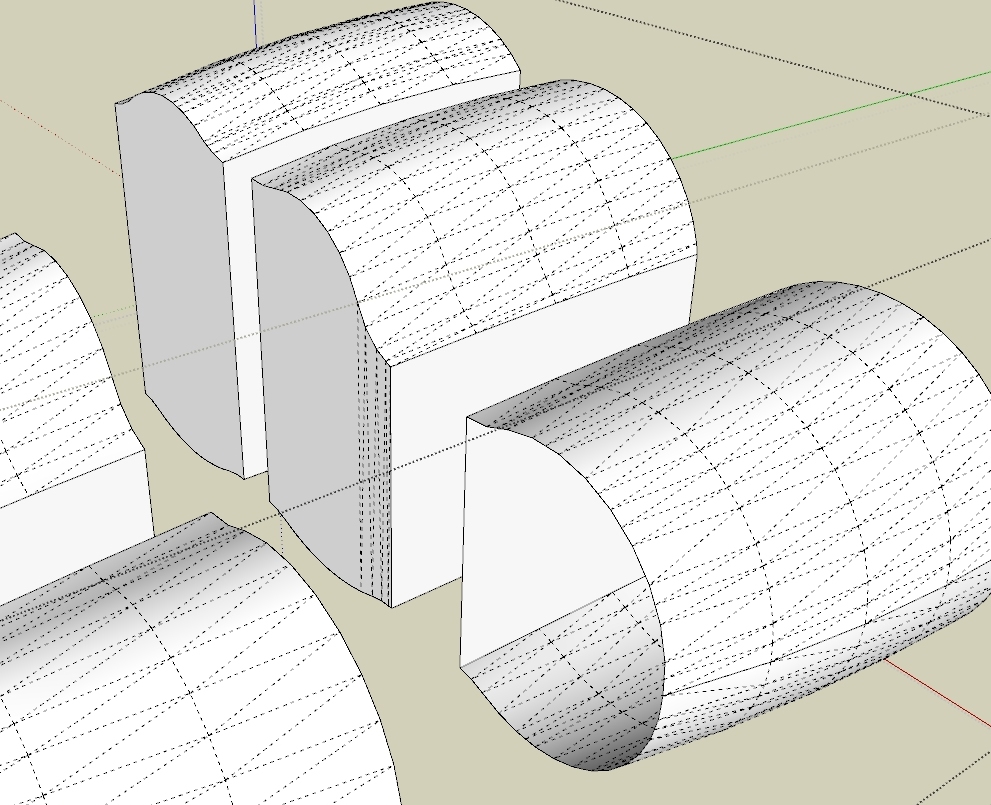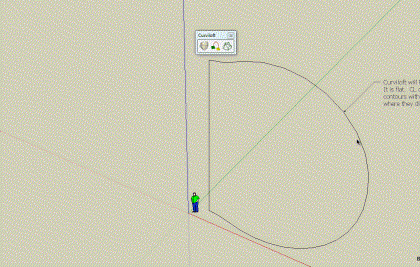[Plugin][$] Curviloft 2.0a - 31 Mar 24 (Loft & Skinning)
-
@compu said:
plugin doesn't work. it's not visible under "tools > fredo6 collection"
can you help me about it?
If you glance back through some of the recent posts in this thread, you'll see that many users can mis-install such tools, or forget to install the supporting Lib set that is clearly indicated and linked in the tool's download page.
Another common error - even after successfully installing the required files and subfolders of files etc - is not realizing that some tools like this need an initial activation as an Extension under the Preferences dialog.
This should then include it in any menu items etc; however, you might need to also activate its toolbar under the View > Toolbar entry to see/use that... -
Fredo,
Curviloft will simply not skin this contour.
It is (or is almost) flat and very similar to about 30 other contours, that skinned with little or no problem where the contours did not flat face with SU's "Face" function.
I have checked every line for doubles, fragments and gaps (none).
I have redrawn most of the lines endpoint to endpoint, especially at junctions.It will form a face if I manually face it, but not with CL.
Could you please tell me why it fails and how you found whatever error I made in it?
[mod=MODERATOR NOTE:3oodv4kq]Removed unnecessary and tiresome overuse of smilies/capitalization.[/mod:3oodv4kq]
-
Joel
You have just managed to contrive a set of almost coplanar edges, and then combine some of them into curves, but then with some that are not... at which CL baulks.
Unsurprisingly!
With a very little adjustment my EEbyRails managed to mesh it - and I freely admit Fredo's tools often has better results than mine do!
My solution works almost instantly - either with the original parts [left] or a more logical/symmetrical split, with an added 'mid-curve' [right].You cannot expect any tool that is in a beta phase, and that is given away freely, to always do what you hope of it - no matter how good it normally performs.
As the original form's author it's up to you to devise a workaround when all else fails.
It took me just a few moments - and of course I care diddly-squat about your project - so surely you could have applied a few of your own brain-cells to come up with a solution to suit your needs...
-
You ccan check that the lines are not coplanar with the section tool. My attempt to solve this... (OK, TIG was faster, Unsurprisingly!)

-

It is not flat. It contained 3 lonely verts. As TIG mentions you seem to not use this tool correctly on a regular basis.
Proper lofting requires an understanding of the lofting process which is heavily covered in Fredo's videos.
Use of 'breaker' edges are needed at times to let Curviloft know what you are trying to loft.
-
For those who do not find the Utilities menu, it has to be activated in the preferences (extensions)...
-
Thanks to all, but.......
First of all, the contour is supposed to be flat, but SU Intersect screwed that up a bit. In the JPG there are 3 sections of my Dirigible concept. There are a total of 73 sections, of which 30 center sections are identical. The rest (nose and tail) were formed from a large mesh created by multiple Curviloft constructs, exploded into 1 humongous shell, nose and tail. I then ran flat quad faces (as a group) across and fore/aft through the shells to create the outer skins of each section with intersect. For some really dumb and inexplicable reason, I deleted the intersecting quad faces. I then grouped each section and spread them apart.
Realizing my error, the next day, obviating any undo, I recreated the flat faces by joining the 4 corners of each top and bottom skin. Of the 43 sections, (actually only 21 due to flipped copies) almost all formed flat faces when the lines were drawn. A few pair needed CL, and they formed a single undivided face (left section in JPG) and only one (center section in JPG) formed with 9 facets.
But there were 3 pairs of faces that refused to form using CL. Two (pairs of) faces I constructed manually (not shown). But the one on the right refused to face unless I connected almost every vertex, like Cotty did manually. I really need these faces to be a single flat face because they will have a post process to form the internal web structure. I can't have lines dividing the faces.
Tig, "it took me just a few moments - and of course I care diddly-squat about your project - so surely you could have applied a few of your own brain-cells to come up with a solution to suit your needs..."
Totally uncalled for.... Of course I can solve this by other means, and for the 3 faces I did, in a few minutes. I tried subdividing the contour into 2 or 3 pieces, and apply CL to each. This almost always works, before I do a manual construct.The main reason I posted this problem is for Fredo. CL should NOT refuse to skin a properly connected and clean contour. I know CL has had problems with nearly flat contours, and Fredo looked at this type of failure before when I brought it up here in this forum. It should not matter to CL if the contour looks like the rocky mountains or the prairies. That's what a Beta is for.
Rich; If the vertices were properly co-planar, the face would form as soon as the 2nd vertical line was drawn, as did in the other 40+ sections. I would not need to resort to Curviloft to make the face.
And finally.......
MODERATOR NOTE
Removed unnecessary and tiresome overuse of smilies/capitalization.REALLY??? You will notice that this post contains only a single smiley and 2 all caps....


-
@jgb said:
The main reason I posted this problem is for Fredo. CL should NOT refuse to skin a properly connected and clean contour.
Joel,
Curviloft (and TIG's ExtrudeEdgesByRail) can generally skin surfaces when 3 or 4 contiguous contoursare given, not more not less. This is called a "coon".
When the contour is rather continuous, you need to indicate where to break it into these 3 or 4 pieces. This can be done by small breaker segments, as illustrated by Rich, or by the user selecting each and freezing it.
Alternatively, you can use TGI3d which has a much more powerful function to skin continuous 3D contours (and maybe Soap Skin & Bubble and Ferrari).
Fredo
-
Tig, Cotty & Rich
You all twigged onto the source of the problem with my contour, exclusive of Curviloft.
You all said I had non co-planar edges, and gave a few solutions to form a face, but none were flat single faces as I needed, as I stated in my original post.
You all missed the obvious......... Bring the vertices into plane.
So, knowing that was the solution, (thanks to you all again) I fixed all 4 pairs in less than 20 minutes.
All I did was delete whatever malformed faces there were, picked a corner that was co-planar with another part of the model, then proceeded, one by one, to move each vertex on the contour perimeter along the green axis to align with that "master" corner. Most were out less than a tenth of an inch, a few as much as an inch.
Then I selected a vertical, "Face" command and a perfect face formed. (Sorry Mod, couldn't resist!
(Sorry Mod, couldn't resist!  )
)Then to ease my task on the corresponding sections mating face, I clip-copied the face, moved it along green to the "master corner" and used Solid Inspector to tell me exactly what needed fixin'.
That still leaves Fredo with the problem of Curviloft vrs. nearly flat contours.
EDIT: (And I just saw Fredo's reply, sent while I was writing this post, which took me longer to write than the fix took)
-
I have tools like 'Project to Plane' that would 'flatten' your slightly non-coplanar edges on to any selected plane [aka 'workplane']. This might be a quick way to 'regularize' your wayward edges ?
Unfortunately, we had all rather assumed that you wanted your original edges to be slightly non-coplanar

Why else might you have made them like that, and then presented them to us like that ?Remember that had all of these edges been coplanar initially, or made so by some adjustment, then no special tools at all would have been needed, because the edges should take a face if one edges is over-drawn, or for more complex forms perhaps if a temporary diagonal [or two] were added...
-
@unknownuser said:
You all missed the obvious......... Bring the vertices into plane.
Apparently you did, too, or this would have been finished business long ago.

-
-
@unknownuser said:
Rich; If the vertices were properly co-planar, the face would form as soon as the 2nd vertical line was drawn, as did in the other 40+ sections. I would not need to resort to Curviloft to make the face.
In your original file there was text saying 'It is flat'. It was not flat so I answered that part.
I then showed how to skin this non-planar ring using CurviLoft and breakers.
There is an appropriate time to use


 smilies and there is an inappropriate way to overuse them. Please use discretion when you decide to decorate your posts with these.
smilies and there is an inappropriate way to overuse them. Please use discretion when you decide to decorate your posts with these. -
Thanks again;
I re-read my OP and I should have been more clear, that the contour was supposed to be flat, based on the fact it was created by a flat intersection. Why it went awry is a mystery.
I assumed it was flat, or nearly so, as stated, so to go the extra step of making it flat never occurred to me, until it was shown that portions were out of plane.
As I said before, CL seems to have problems with some almost flat contours. It should not matter if the contour resembles the rocky mountains or the prairies.
And again, my OP intent was very much more-so to show Fredo a case where CL failed to skin, than to get a solution. And if I had made a mistake in forming the contour, just what was that error and how did you find it. Both of those reasons were far more important than the actual solution.
Fredo, as far as breakers are concerned, I do use them when CL (on occasion) gives me an inconsistent/weird curve. But this time, there were no pretty colored lines, just a blank non response from CL. And I do get these blank responses from CL even when there are very clear and distinctive sections to a contour.
I (we all) eagerly await your "Contour Inspector". either as a stand-alone Ruby or as an integral part of Curviloft.
Tig; I will look into that, thanks.
Rich, see? only 1 smiley

 (OK, 2)
(OK, 2) -
@jgb said:
Fredo, as far as breakers are concerned, I do use them when CL (on occasion) gives me an inconsistent/weird curve. But this time, there were no pretty colored lines, just a blank non response from CL. And I do get these blank responses from CL even when there are very clear and distinctive sections to a contour.
Curviloft is not really finished and the error handling is deficient.
When you don't get a skinning, then it is because Curviloft does not have enough information to perform it. A message would of course be welcome. I'll include error detection in a next version.Fredo
-
BTW Is there a skinning video? I periodically watch the other videos at the top of thread, as I seem not to catch or retain all of it on one viewing.
-
-
fredo, you are a coding god! this is absolutely amazing.
-
I'm on a Mac and I can't get curv a loft to install properly. I get an error message when I start SU. I copied everything to the plug in directory including the separate library download. There is an entry in the windows dropdown but no tool bar available. Can someone help me with this...I really need to start using the plug in for a project
Frank Trocino
ftrocino@earthlink.net -
If you get an error message related to the plugin when you first start SU, you've installed the plugin incorrectly. Since you told us what the error message is, it is impossible to diagnose beyond that. Correct installation has been covered repeatedly in this thread. Please read through it. Fredo's first post shows the footprint of the plugin. Make sure it matches on your machine.
Advertisement











